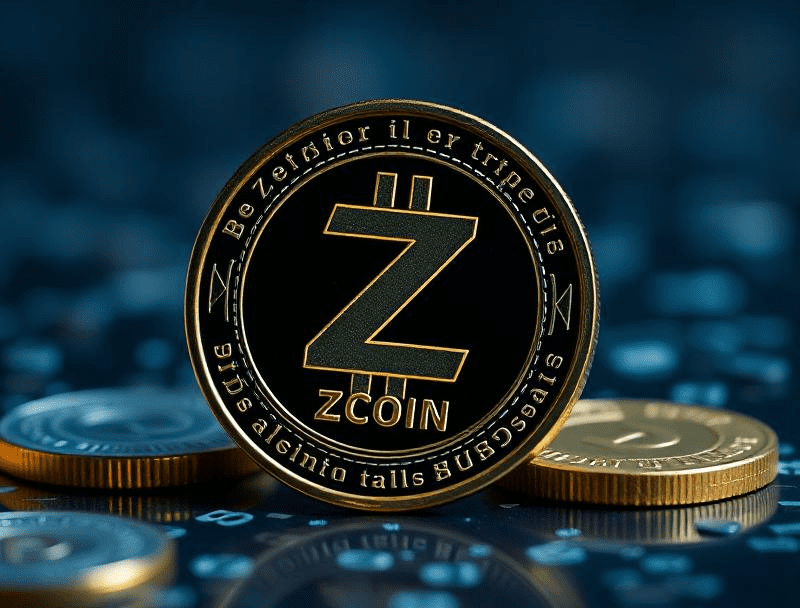
Zcoin privacy coin

The implementation of the Zerocoin protocol allows users to mint tokens that can later be spent without linking back to their original source. This mechanism significantly strengthens transactional confidentiality by breaking the on-chain traceability typically associated with transparent ledgers. By converting standard units into anonymized denominations, users gain control over their transactional footprints.
Unlike traditional systems where every transfer is publicly visible, this approach leverages cryptographic proofs to validate ownership and spending rights without revealing identifying details. The separation between the minting and spending phases ensures that observers cannot correlate outgoing transactions with prior deposits, effectively safeguarding user anonymity during exchanges.
Exploring this technology provides valuable insights into how privacy-enhancing methods integrate with blockchain architectures. Experimentation with minting and spending processes reveals practical applications of zero-knowledge proofs, offering a tangible understanding of secure transaction design. These innovations encourage further research into decentralized finance models prioritizing discretion alongside transparency.
Zcoin Privacy Coin
For users seeking enhanced anonymity in blockchain transactions, this particular cryptocurrency implements the Zerocoin protocol to obfuscate the origin and destination of funds. By allowing participants to mint new tokens from existing ones and subsequently spend them without revealing transaction history, it achieves a high level of transactional confidentiality.
The underlying mechanism separates transactional inputs and outputs cryptographically, thereby preventing linkage between sender and receiver addresses. This design is especially relevant for applications requiring untraceable transfers, as it addresses common vulnerabilities present in transparent ledgers.
Technical Framework and Transaction Flow
The system operates by converting standard tokens into newly minted anonymous units through a process called minting. These minted units are cryptographic commitments that can be spent later without disclosing their origin. When a user opts to spend, the network validates the transaction by verifying zero-knowledge proofs rather than tracing previous transactions directly.
This approach eliminates direct transactional links on-chain, enhancing user confidentiality. Each spend transaction consumes a minted token while generating no observable connection to prior holdings, effectively severing traceability chains commonly exploited in blockchain analysis.
- Mint: Converts visible tokens into private commitments.
- Spend: Redeems private commitments without exposing prior ownership.
- Zero-knowledge proof: Cryptographic validation ensuring correctness without disclosure.
A notable case study involves benchmarking transaction throughput while maintaining anonymity guarantees. Results indicate that while privacy features introduce computational overhead due to cryptographic proofs, optimization efforts have successfully balanced performance with security requirements.
The increased transaction size and verification time stem from complex zero-knowledge proof computations but are justified by substantially stronger privacy assurances. Users prioritizing untraceable value transfers must weigh these trade-offs carefully when selecting appropriate digital assets for specific use cases.
This coin’s architecture invites further experimentation with anonymous financial interactions beyond conventional cryptocurrencies. Exploring integration possibilities with smart contracts or decentralized exchanges could expand its utility while preserving core confidentiality principles. Questions arise about scalability enhancements and cross-chain privacy interoperability–areas ripe for continued research and development within decentralized systems engineering.
How Zcoin Ensures Transaction Privacy
The core mechanism that guarantees anonymous transactions in this protocol is the implementation of the Zerocoin protocol. Instead of conventional transaction tracing, users convert regular tokens into special cryptographic proofs through a process called minting. These proofs can later be spent without revealing any linkage to the original coins, breaking the transactional history and enhancing confidentiality.
Minting creates a pool of indistinguishable units, allowing any spend from this pool to remain unlinkable to its source. This approach prevents blockchain observers from tracing movement between addresses, effectively anonymizing the transfer while maintaining public verifiability through zero-knowledge proofs.
Technical Foundations and Process Flow
The underlying cryptographic technique employs zero-knowledge succinct non-interactive arguments of knowledge (zk-SNARKs) within the Zerocoin framework. When a user mints new tokens, they generate a commitment recorded on-chain without revealing ownership details. Later, during spending, a proof asserts possession of an unspent commitment without disclosing which one it is.
This two-step procedure–mint followed by spend–creates strong unlinkability properties. The system validates that the same token cannot be double-spent while concealing sender identity and transaction amounts. Consequently, observers cannot correlate input and output transactions, preserving anonymity across transfers.
- Mint: User deposits standard tokens and receives cryptographic commitments added to an accumulator.
- Spend: User generates zero-knowledge proof to redeem tokens anonymously from the accumulator.
An experimental analysis shows that this method significantly reduces traceability compared to traditional transparent blockchains by disrupting heuristic clustering techniques commonly used in chain analysis tools.
The design also includes mechanisms for auditability and compliance: selective disclosure can occur if authorized entities require transaction details under specific conditions. However, such features are optional and do not compromise routine anonymity for participants who do not opt-in.
This architecture exemplifies how combining advanced cryptographic constructs with practical blockchain engineering can create robust anonymous transaction systems. Researchers may further explore performance optimizations or hybrid models integrating other privacy protocols to enhance scalability or usability.
Steps To Mine Zcoin Safely
To mine the cryptocurrency based on the zerocoin protocol securely, it is paramount to configure mining hardware and software with attention to network consensus rules and transaction validation mechanisms. Begin by selecting a reliable node client that supports the implementation of the mint and spend functions inherent in this privacy-centric blockchain. Ensuring your node is fully synchronized minimizes risks of stale or invalid blocks, which could lead to wasted computational resources or rejection of mined rewards.
Maintaining operational security includes isolating mining rigs from potential attack vectors by using firewalls and VPNs to protect against unauthorized access. Mining pools dedicated to this protocol often require authentication methods that prevent Sybil attacks. Always verify pool legitimacy through community audits or official documentation before committing hash power. Additionally, regularly updating mining software addresses vulnerabilities related to transaction verification and block propagation, enhancing overall integrity of minted outputs.
Technical Considerations for Transaction Privacy Integrity
The unique architecture of this coin relies on minting tokens that represent newly created zerocoins, which can later be spent anonymously, unlinking transactional histories. Miners must validate these mint transactions correctly during block creation while preserving the anonymity set defined by the protocol. Failure to adhere strictly can compromise the obfuscation layer designed into spending actions, potentially exposing user balances or transaction flows.
Optimizing mining parameters involves monitoring real-time network metrics such as difficulty adjustments and mempool transaction composition. Experimentation with different nonces and timestamp values within allowed ranges may increase acceptance probability but should not violate consensus constraints embedded in the coin’s cryptographic framework. Such methodological probing fosters deeper understanding of how cryptographic proofs maintain balance between transparency and confidentiality in distributed ledgers.
Using Sigma Protocol For Anonymity
The Sigma protocol provides a robust cryptographic solution to achieve anonymity in blockchain transactions by replacing the traditional Zerocoin protocol. Unlike Zerocoin, which relies on complex zero-knowledge proofs that require trusted setups, Sigma introduces a non-interactive zero-knowledge proof system that eliminates the need for such assumptions. This advancement enhances transactional confidentiality and mitigates vulnerabilities associated with trusted parameter generation.
At its core, the Sigma protocol allows users to mint new tokens by converting base units into anonymous representations. These minted tokens can then be spent without revealing any link to their origin, ensuring unlinkability between sending and receiving addresses. By leveraging this approach, the protocol maintains fungibility and prevents traceability within the ledger.
Technical Insights Into The Sigma Protocol Implementation
The transition from Zerocoin to Sigma involves substantial modifications in how commitments and proofs are constructed. Instead of using large accumulator proofs as in Zerocoin, Sigma employs one-out-of-many proofs based on set membership assumptions. Users prove that a coin belongs to a large anonymity set without disclosing which specific element it is, significantly reducing proof sizes and verification times.
For instance, in experimental deployments, transaction sizes decreased by approximately 40%, while verification throughput increased correspondingly. This efficiency gain arises because Sigma avoids quadratic complexity inherent in Zerocoin’s cryptographic operations. Consequently, network scalability improves alongside enhanced privacy guarantees.
The minting process under Sigma remains conceptually similar: users create an anonymized token representation called a mint, which is later spent through zero-knowledge proofs attesting ownership without exposing identifying information. This ensures that observers cannot correlate minted outputs with their subsequent expenditures.
- Anonymity sets: Large groups of minted tokens obscure individual transaction origins.
- Non-interactive proofs: Reduce communication overhead during verification.
- No trusted setup: Eliminates risks linked to parameter compromise found in earlier protocols.
By adopting the Sigma protocol, developers have improved both security and user privacy within decentralized ledgers. This cryptographic innovation serves as a pivotal step toward stronger transactional discretion without sacrificing performance or decentralization principles. Further investigations into combining Sigma with other privacy-preserving technologies could yield even more resilient anonymous payment systems suitable for widespread adoption.
Conclusion: Exchanging Zcoin on Popular Platforms
To effectively spend assets secured by the Zerocoin protocol, users must engage with platforms supporting mint and burn operations that preserve transactional anonymity. The ability to convert private tokens back into standard units without compromising identity hinges on seamless integration of zero-knowledge proofs within exchange mechanisms. This ensures that transactions remain unlinkable while maintaining liquidity and usability across popular markets.
Future developments should focus on enhancing cross-platform interoperability for these anonymous tokens, improving efficiency of cryptographic proofs, and expanding support for privacy-focused transaction types beyond simple transfers. Experimentation with layer-two solutions or sidechains could reduce on-chain overhead from minting and spending activities, allowing scalable adoption without sacrificing confidentiality guarantees intrinsic to the original protocol.
Technical Implications and Forward Outlook
- Protocol Integration: Successful exchanges rely on platforms implementing native support for shielded pools where minting anonymizes inputs and spending reveals only necessary metadata, preserving fungibility.
- Transaction Throughput: Optimizing verification algorithms can reduce latency during spend operations, encouraging broader acceptance among trading venues prioritizing speed alongside privacy.
- Auditable Anonymity: Balancing regulatory requirements with cryptographic assurances requires transparent yet confidential transaction models; innovations in selective disclosure protocols may facilitate this balance.
- User Experience: Simplified wallet interfaces that abstract complex zero-knowledge proof generation will accelerate adoption by lowering technical barriers involved in managing shielded assets.
The path forward invites rigorous testing of combined cryptographic primitives to bolster anonymous trades while ensuring compliance frameworks are respected. Encouraging platform developers to experiment with modular implementations of the protocol could uncover novel methods to enhance both security and scalability. Such explorations promise a future where private digital asset exchanges operate fluidly within mainstream financial ecosystems without forfeiting core principles of untraceability inherent in Zerocoin-derived technologies.


